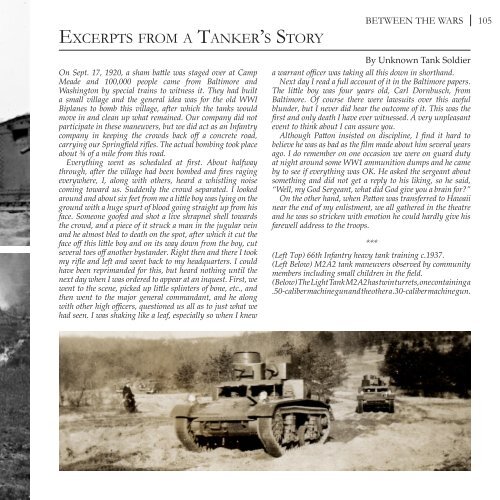Fort George G. Meade: The First 100 Years
You may know Fort George G. Meade as a cyber and intelligence hub, but did you know that the installation used to be the home of Army Tank School after World War I? Or that it housed an internment camp at the start of World War II for primarily German-American and Italian-American citizens and foreign nationals? Learn more about the fascinating history of the third largest Army base in the U.S. in terms of number of workforce in this book.
You may know Fort George G. Meade as a cyber and intelligence hub, but did you know that the installation used to be the home of Army Tank School after World War I? Or that it housed an internment camp at the start of World War II for primarily German-American and Italian-American citizens and foreign nationals? Learn more about the fascinating history of the third largest Army base in the U.S. in terms of number of workforce in this book.
You also want an ePaper? Increase the reach of your titles
YUMPU automatically turns print PDFs into web optimized ePapers that Google loves.
Excerpts from a Tanker’s Story<br />
BETWEEN THE WARS<br />
105<br />
On Sept. 17, 1920, a sham battle was staged over at Camp<br />
<strong>Meade</strong> and <strong>100</strong>,000 people came from Baltimore and<br />
Washington by special trains to witness it. <strong>The</strong>y had built<br />
a small village and the general idea was for the old WWI<br />
Biplanes to bomb this village, after which the tanks would<br />
move in and clean up what remained. Our company did not<br />
participate in these maneuvers, but we did act as an Infantry<br />
company in keeping the crowds back off a concrete road,<br />
carrying our Springfield rifles. <strong>The</strong> actual bombing took place<br />
about ¾ of a mile from this road.<br />
Everything went as scheduled at first. About halfway<br />
through, after the village had been bombed and fires raging<br />
everywhere, I, along with others, heard a whistling noise<br />
coming toward us. Suddenly the crowd separated. I looked<br />
around and about six feet from me a little boy was lying on the<br />
ground with a huge spurt of blood going straight up from his<br />
face. Someone goofed and shot a live shrapnel shell towards<br />
the crowd, and a piece of it struck a man in the jugular vein<br />
and he almost bled to death on the spot, after which it cut the<br />
face off this little boy and on its way down from the boy, cut<br />
several toes off another bystander. Right then and there I took<br />
my rifle and left and went back to my headquarters. I could<br />
have been reprimanded for this, but heard nothing until the<br />
next day when I was ordered to appear at an inquest. <strong>First</strong>, we<br />
went to the scene, picked up little splinters of bone, etc., and<br />
then went to the major general commandant, and he along<br />
with other high officers, questioned us all as to just what we<br />
had seen. I was shaking like a leaf, especially so when I knew<br />
By Unknown Tank Soldier<br />
a warrant officer was taking all this down in shorthand.<br />
Next day I read a full account of it in the Baltimore papers.<br />
<strong>The</strong> little boy was four years old, Carl Dornbusch, from<br />
Baltimore. Of course there were lawsuits over this awful<br />
blunder, but I never did hear the outcome of it. This was the<br />
first and only death I have ever witnessed. A very unpleasant<br />
event to think about I can assure you.<br />
Although Patton insisted on discipline, I find it hard to<br />
believe he was as bad as the film made about him several years<br />
ago. I do remember on one occasion we were on guard duty<br />
at night around some WW1 ammunition dumps and he came<br />
by to see if everything was OK. He asked the sergeant about<br />
something and did not get a reply to his liking, so he said,<br />
“Well, my God Sergeant, what did God give you a brain for?”<br />
On the other hand, when Patton was transferred to Hawaii<br />
near the end of my enlistment, we all gathered in the theatre<br />
and he was so stricken with emotion he could hardly give his<br />
farewell address to the troops.<br />
***<br />
(Left Top) 66th Infantry heavy tank training c.1937.<br />
(Left Below) M2A2 tank maneuvers observed by community<br />
members including small children in the field.<br />
(Below) <strong>The</strong> Light Tank M2A2 has twin turrets, one containing a<br />
.50-caliber machine gun and the other a .30-caliber machine gun.


